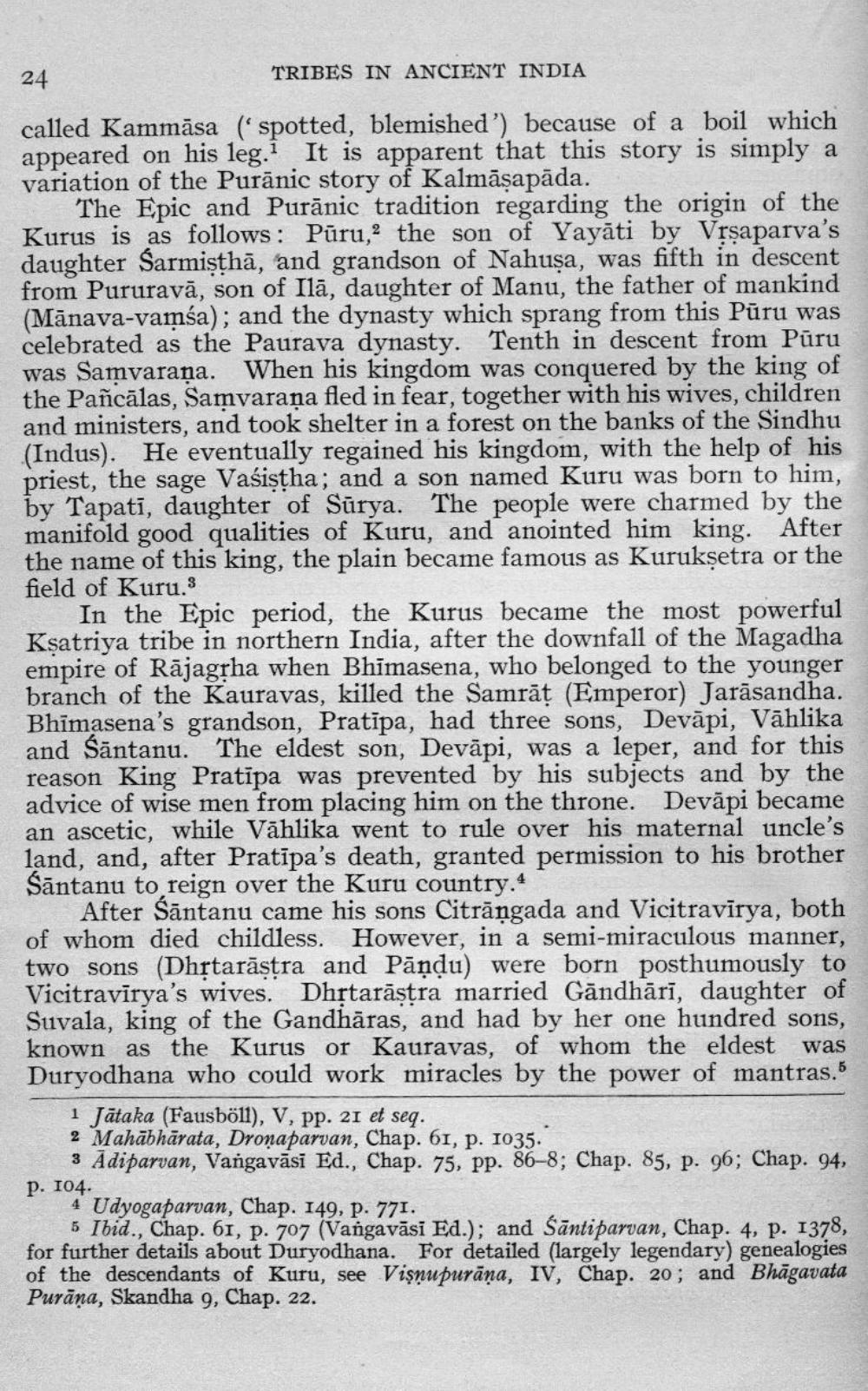________________
24
TRIBES IN ANCIENT INDIA
called Kammāsa (spotted, blemished') because of a boil which appeared on his leg. It is apparent that this story is simply a variation of the Purānic story of Kalmāşapāda.
The Epic and Purānic tradition regarding the origin of the Kurus is as follows: Pūru, the son of Yayāti by Vrsaparva's daughter Sarmişthā, and grandson of Nahusa, was fifth in descent from Pururavă, son of Ilā, daughter of Manu, the father of mankind (Mānava-vamsa); and the dynasty which sprang from this Pūru was celebrated as the Paurava dynasty. Tenth in descent from Pūru was Samvaraña. When his kingdom was conquered by the king of the Pañcālas, Samvaraṇa fled in fear, together with his wives, children and ministers, and took shelter in a forest on the banks of the Sindhu (Indus). He eventually regained his kingdom, with the help of his priest, the sage Vasistha; and a son named Kuru was born to him, by Tapati, daughter of Sūrya. The people were charmed by the manifold good qualities of Kuru, and anointed him king. After the name of this king, the plain became famous as Kuruksetra or the field of Kuru.
In the Epic period, the Kurus became the most powerful Ksatriya tribe in northern India, after the downfall of the Magadha empire of Rājagrha when Bhimasena, who belonged to the younger branch of the Kauravas, killed the Samrāț (Emperor) Jarāsandha. Bhimasena's grandson, Pratipa, had three sons, Devāpi, Vāhlika and sāntanu. The eldest son, Devāpi, was a leper, and for this reason King Pratipa was prevented by his subjects and by the advice of wise men from placing him on the throne. Devāpi became an ascetic, while Vählika went to rule over his maternal uncle's land, and, after Pratīpa's death, granted permission to his brother Sāntanu to reign over the Kuru country.4
After śāntanu came his sons Citrāngada and Vicitravīrya, both of whom died childless. However, in a semi-miraculous manner, two sons (Dhịtarăstra and Pāņdu) were born posthumously to Vicitravirya's wives. Dhrtarăstra married Gāndi
married Gāndhārī. daughter of Suvala, king of the Gandhāras, and had by her one hundred sons, known as the Kurus or Kauravas, of whom the eldest was Duryodhana who could work miracles by the power of mantras.5
1 Tātaka (Fausböll), V, pp. 21 et seg. 2 Mahābhārata, Dronaparvan, Chap. 61, p. 1035.
3 Adiparvan, Vangavāsi Ed., Chap. 75, pp. 86–8; Chap. 85, p. 96; Chap. 94, p. 104.
4 Udyogaparvan, Chap. 149, p. 771.
5 Ibid., Chap. 61, p. 707 (Vangavāsi Ed.); and śāntiparvan, Chap. 4, p. 1378, for further details about Duryodhana. For detailed (largely legendary) genealogies of the descendants of Kuru, see Vişnupurāna, IV, Chap. 20; and Bhāgavata Purãna, Skandha 9, Chap. 22.




